Travels
The Biggest Tourist Attractions of Uzbekistan
Uzbekistan’s pearl of Central Asia occupying a key place on the Silk Road. A country where you can feel the wind of desert and see the disappearing Aral Sea. The world of blue mosques, traditional madras and old fortresses contrasts with the havoc left by the communist regime.
In Uzbekistan we can find numerous cultural monuments and natural wonders worth seeing. Here you will find a hint of what to visit during your first trip to this beautiful country.
Tashkent – post-Soviet juggernaut or a city with history?
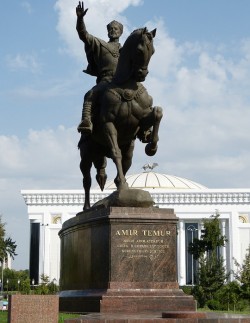 Monument to Timur on horseback near the Emir Timur Museum Public domainTashkent is the capital of Uzbekistan and one of the largest cities in Central Asia. It has about 2.5 million inhabitants. There is a modern center with the monument to victims of the great earthquake of 1966, during which a large part of the city was destroyed. It was rebuilt on the pattern of Soviet buildings – monumental greys, perpendicular streets, large slab buildings. Independence Square is located in the center, where once the highest monument of Lenin was situated, now replaced by a large globe, on which only one state is marked – Uzbekistan. Tashkent is the only one among the cities of Central Asia that can boast of the subway, operating since 1977, as well as the highest TV tower in the region.
Monument to Timur on horseback near the Emir Timur Museum Public domainTashkent is the capital of Uzbekistan and one of the largest cities in Central Asia. It has about 2.5 million inhabitants. There is a modern center with the monument to victims of the great earthquake of 1966, during which a large part of the city was destroyed. It was rebuilt on the pattern of Soviet buildings – monumental greys, perpendicular streets, large slab buildings. Independence Square is located in the center, where once the highest monument of Lenin was situated, now replaced by a large globe, on which only one state is marked – Uzbekistan. Tashkent is the only one among the cities of Central Asia that can boast of the subway, operating since 1977, as well as the highest TV tower in the region.
The city’s main historical and cultural assets include numerous museums, beautiful mosques and breathtaking mausoleums. There is also a madrassa: Barak-Khana and Kukeldash from the 16th century – the largest and best preserved Koranic schools in this part of the world, the Djuma Mosque, the Hazrati Imam Mausoleum – commemorating one of the first imams of Tashkent.
The greatest historical gem is the original of the Achman Koran, one of the four oldest copies of this Holy Book of Islam in the world. Written on parchment in the 7th century and stored in the library of the Friday mosque. In this library there are about 20 thousand precious Islamic books.
If you are an art lover, you will certainly not be bored. Worth recommending are the Emir Timur Museum, the Museum of History – the largest in the city, the Museum of Fine Arts of Uzbekistan with a rich collection of exhibits from ancient times to contemporary times and the Alisher Navoi Museum of Literature with numerous replicas of manuscripts, examples of 15th century Persian calligraphy and miniature painting.
While in Tashkent, it is certainly worth visiting the great marketplace of Chorsu, the largest and oldest bazaar in this part of Asia. It has a unique atmosphere and shows the local color.
Khiva – a fortress city
Full of monuments, the capital of ancient Khwarazm. Once one of the main commercial centers in the Central Asia region, now a quiet, majestic place with the beautiful old town of Itchan Kala listed in the UNESCO World Heritage List. There are more than 50 historical monuments in the Old Town and about 250 houses, mostly from the 18th and 19th century.
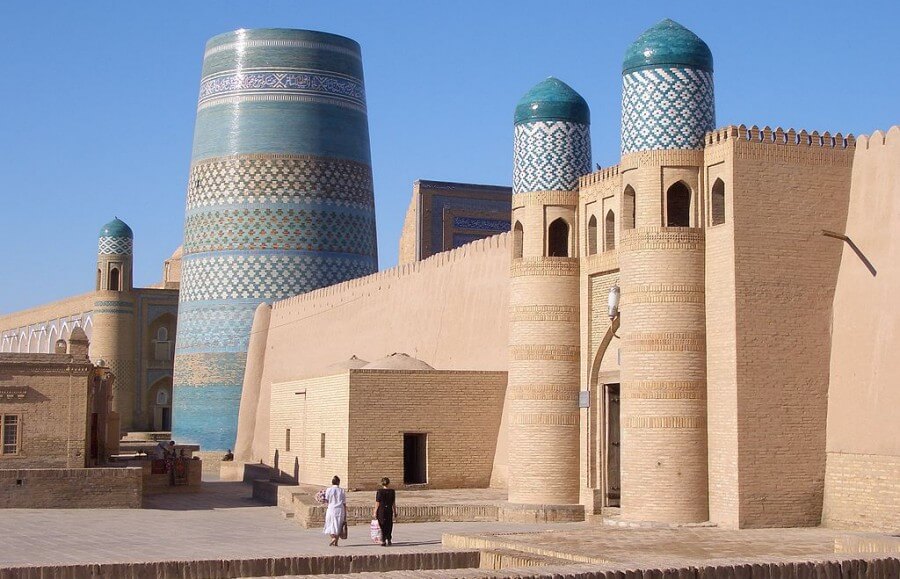 Kalta Minor minaret in Khiva / Bosinus / CC-BY-SA-3.0 / Wikimedia Commons
Kalta Minor minaret in Khiva / Bosinus / CC-BY-SA-3.0 / Wikimedia CommonsThe most important monuments of the town include the 17th century defensive walls, the Kunya-ark citadel (17th-19th century), Makhmud Pahlavan’s mausoleum, the Djum mosque (18th century), madrassas with Allakuli-khan and Amin-khan minarets and Tash-Khovli Palace. The most famous building is the powerful Kalta Minor minaret, which was supposed to be the largest in the world, but was never completed. From the highest tower at the mosque you can see a charming panorama of the area with the Kyzyl-Kum desert.
Bukhara – a sacred city
 Ark Citadel - Main Gate / David Stanley / CC BY 2.0 / Wikimedia CommonsThe city is full of colors and is an important cultural and religious center of this region. In the past it was an important trading place on the Silk Road. It has a rich history and wonderful architecture, and the Old Town is full of magnificent buildings, which have not changed much over the last centuries. In 1993, the historic center of Bukhara was inscribed on the UNESCO World Heritage List. It is one of the most valuable Islamic architectural complex in Central Asia and includes about 140 buildings.
Ark Citadel - Main Gate / David Stanley / CC BY 2.0 / Wikimedia CommonsThe city is full of colors and is an important cultural and religious center of this region. In the past it was an important trading place on the Silk Road. It has a rich history and wonderful architecture, and the Old Town is full of magnificent buildings, which have not changed much over the last centuries. In 1993, the historic center of Bukhara was inscribed on the UNESCO World Heritage List. It is one of the most valuable Islamic architectural complex in Central Asia and includes about 140 buildings.
The oldest monument of the Bukhara is the Ark Citadel – an old fortress surrounded by walls, which in the Middle Ages was a separate city with an emir’s palace, mint, mosques and government institutions. Nowadays, there are beautiful minarets, madrassas and several museums and galleries.
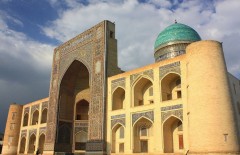 Mir-i Arab Madrasah / RK / CC BY-SA 4.0 / Wikimedia CommonsIt is also worth visiting the Samanid Mausoleum (the oldest surviving Muslim mausoleum in Central Asia), the Magoki-Attori mosque, the Poi-Kalyan architectural team (including the Kalyan minaret from 1127 with a height of 46 meters (150 ft) – the highest in Uzbekistan), or the Kalyan mosque from the 15th century (Miri-Arab and Amir-Alimkhan madrassas are also located nearby). All this is a true gem of Islamic architecture.
Mir-i Arab Madrasah / RK / CC BY-SA 4.0 / Wikimedia CommonsIt is also worth visiting the Samanid Mausoleum (the oldest surviving Muslim mausoleum in Central Asia), the Magoki-Attori mosque, the Poi-Kalyan architectural team (including the Kalyan minaret from 1127 with a height of 46 meters (150 ft) – the highest in Uzbekistan), or the Kalyan mosque from the 15th century (Miri-Arab and Amir-Alimkhan madrassas are also located nearby). All this is a true gem of Islamic architecture.
One of the most popular places in Bukhara is the Lyabi-Khauz building complex. The place is surrounded by open-air restaurants and stores located in historic madrassas. Beautifully decorated interiors and entrances to the Kukeldash madrassa, Nadir Divan-begi, Ulugbek (the oldest in Central Asia) and Abdullazizkhan are an important part of the city landscape.
Samarkand – turquoise pearl of Uzbekistan
The legendary town of the Silk Road, as well as one of the oldest inhabited cities in the world, which dates back to the 6th century BC. In times of greatness, the largest metropolis in Central Asia. It presents the beauty of Islamic architecture, which is dominated by turquoise and blue, and all historic buildings delight with their extraordinary majesty and simplicity. In 2001, the Samarkand was inscribed in the UNESCO World Heritage List.
The heart of the city is Registan, an impressive square surrounded by three monumental Ulugbek, Sher-Dor and Tilla-Kari madrassas, the towers of which offer an amazing view of the entire area.
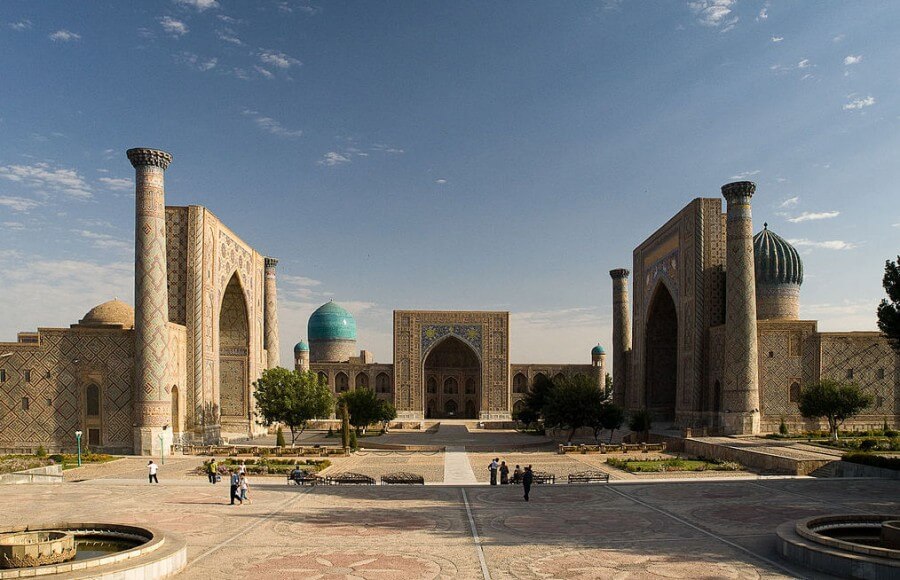 Registan square. On the left madrasah Ulugbek, in the middle madrasah Tilla-Kari, on the right madrasah Sher-dor / Gustavo Jeronimo / CC BY 2.0 / Wikimedia Commons
Registan square. On the left madrasah Ulugbek, in the middle madrasah Tilla-Kari, on the right madrasah Sher-dor / Gustavo Jeronimo / CC BY 2.0 / Wikimedia Commons
In Samarkand, it is also worth seeing the unusual Shakhi Zinda cemetery complex, the tomb of Tamerlan – Gur Emir, Bibi Hanim mosque from the 15th century, Rukhabad Mausoleum and the first medieval astronomical observatory UlukBek. All these attractions are the Samarkand’s image and are important in the national history.
Shakhrisabz – the city of Tamerlane
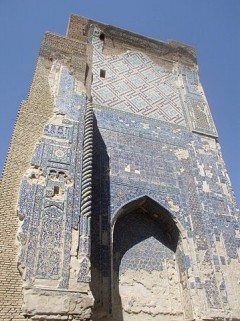 Fragment of the facade of Ak Saray Palace / Alaexis / CC BY-SA 2.5 / Wikimedia CommonsVisiting the Samarkand, it is worthwhile to take a look at the Shakhrisabz, 85 km (53 miles) south of Samarkand, which is also inscribed in the UNESCO World Heritage List. The city is a center of architectural development and is a well-known artisan center in Central Asia. It is here that the greatest national hero of Uzbekistan, Tamerlane, was born. Thanks to him the place became an important center of science and art.
Fragment of the facade of Ak Saray Palace / Alaexis / CC BY-SA 2.5 / Wikimedia CommonsVisiting the Samarkand, it is worthwhile to take a look at the Shakhrisabz, 85 km (53 miles) south of Samarkand, which is also inscribed in the UNESCO World Heritage List. The city is a center of architectural development and is a well-known artisan center in Central Asia. It is here that the greatest national hero of Uzbekistan, Tamerlane, was born. Thanks to him the place became an important center of science and art.
It is worth visiting the Old Town, where most of the monuments of historical value are located: Amir Timur Museum – the crypt where he was buried, Ak Saray – the remains of a palace from the 14th century, where the chief lived, Dorus Saodat (including Jahongir and Omar Sheikh mausoleums) as well as Dorut Tilovat and Kok-Gumbaz mosque.
Within the city there is an active 15th century bathhouse and an indoor marketplace where you can buy everything from local dishes to richly decorated handicrafts.
Aral Sea (Muynak) – disappearing lake
The Aral Lake is a closed drainage salty lake located in Kazakhstan and Uzbekistan. At the time of its greatness, due to its huge size – 428 km (266 miles) long and 234 km (145 miles) wide, with a maximum depth of 69 meters (226 ft), it was called the Aral Sea.
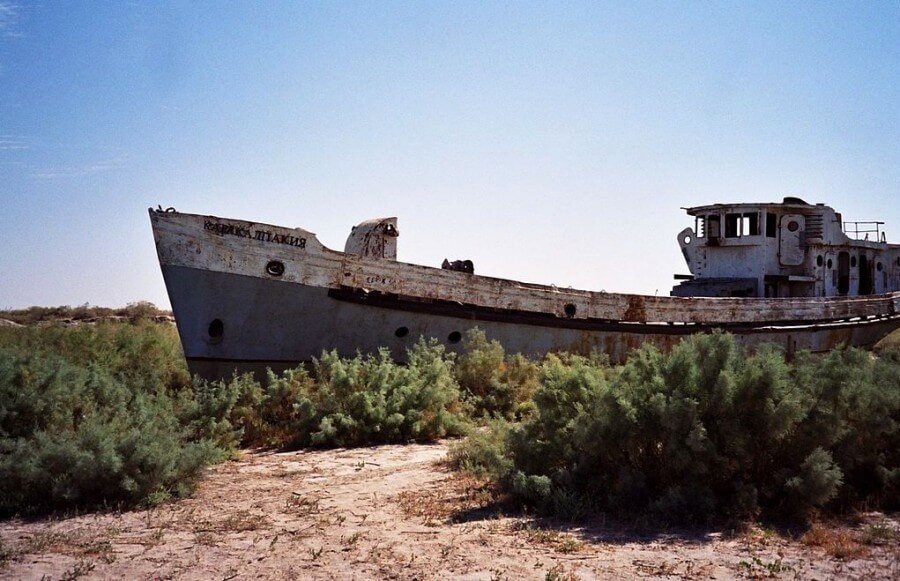 Ship graveyard near Muynak / upyernoz / CC BY 2.0 / Wikimedia Commons
Ship graveyard near Muynak / upyernoz / CC BY 2.0 / Wikimedia CommonsA good place to see what is left out of it is the small town of Muynak. It used to be a bustling port town of 400 thousand people, famous for fishing and fish processing. Today, about 19 thousand people live there. The town is surrounded by sand, and the main attraction is a ship cemetery in the desert.
The Soviet programme for the economic development of the country, initiated in the 1930s, assumed the use of two lake tributaries for agriculture – Amu-daria in the south and Syr-daria in the north. Poorly conducted irrigation of cotton and rice fields dried up the great Amu-Daria River and the Aral Lake it fed began to disappear. In 2009, the lake area was only 13.5 thousand km² (5.2 thousand square miles), more than five times less than in 1960. The environment was contaminated, the microclimate changed, industry and economy collapsed. The drying lake is one of the biggest ecological disasters in the world. Once rich fishing grounds led to the creation of thriving port cities on the coast. Nowadays, the waters of this lake have moved away from them even 100 km (62 miles) and life in them has died.
Bazaars – quintessence of the Silk Road
If you want to feel a real, oriental climate of Uzbekistan, you should go to a traditional bazaar, of which there are at least a few in each city. There is a huge number of evenly arranged vegetables, fruits, pistachios, nuts and aromatic spices. Stands full of fresh bread, dairy, homemade cheese, encourage shopping. The bazaar is a paradise for lovers of sweets, nuts, homemade chocolates, gluten and nougats with various additions. Walking along the shopping alleys, visitors can try traditional dishes: samsa (small buns stuffed with meat, served hot), manti (dumplings made of thin pastry stuffed with meat), lamb and beef skewers, kebab, grilled meat served with sauce and vegetables, lagman (pasta with meat and vegetables cooked in broth), pilaf (fried rice with pieces of meat and vegetables).
In addition to delicacies, the Uzbek bazaars have plenty of beautiful handicrafts, hand-painted porcelain in blue and light blue colors such as mosaics on the mosques and a lot of wood products: wooden frames, bowls, chess, shelves for books, furniture, decorative doors and columns (characteristic of Khiva). On the city markets you can also buy embroidered fabrics, silk scarves, velvet dresses, vests, hand-woven carpets and made of natural furs. You can also taste traditional wine.
Written by: Tim Smith Tags: Asia, Uzbekistan

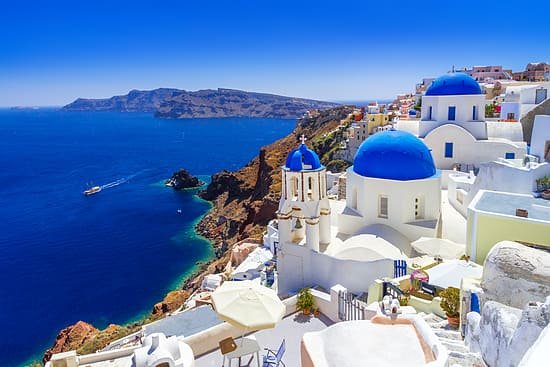




Comments